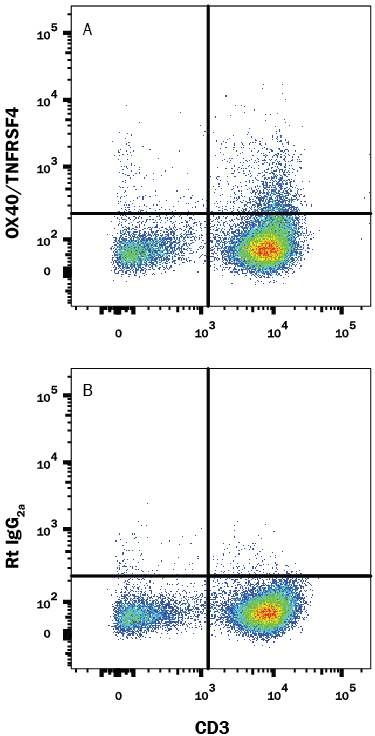Human OX40/TNFRSF4 Fluorescein-conjugated Antibody Summary
Leu29-Ala216
Accession # P43489
Applications
Please Note: Optimal dilutions should be determined by each laboratory for each application. General Protocols are available in the Technical Information section on our website.
Scientific Data
 View Larger
View Larger
Detection of OX40/TNFRSF4 in Human PBMCs by Flow Cytometry. Human peripheral blood mononuclear cells (PBMCs) were stained with Mouse Anti-Human CD3 APC-conjugated Monoclonal Antibody (Catalog # FAB100A) and either (A) Rat Anti-Human OX40/TNFRSF4 Fluorescein-conjugated Monoclonal Antibody (Catalog # FAB3388F) or (B) Rat IgG2AFluorescein Isotype Control (Catalog # IC006F). View our protocol for Staining Membrane-associated Proteins.
Reconstitution Calculator
Preparation and Storage
- 12 months from date of receipt, 2 to 8 °C as supplied.
Background: OX40/TNFRSF4
OX40 (CD134; TNFRSF4) is a T cell co‑stimulatory molecule of the TNF receptor superfamily that coordinates with other membrane-bound co‑stimulators such as CD28, CD40, CD30, CD27 and 4-1BB (1‑3). OX40 is expressed on naïve CD4+ T cells only after engagement of the TCR by antigen presenting cells (APC; dendritic and B cells), and co‑stimulation by CD40/CD40 ligand and CD28/B7. It is maximal at 2‑5 days post activation, or 4 hours post reactivation of memory T cells (3‑6). Human OX40 is a 48 kDa type I transmembrane glycoprotein with a 28 amino acid (aa) signal sequence, a 185 aa extracellular domain (ECD) that has four TNFR-Cys repeats and an O-glycosylated hinge region, a 20 aa transmembrane segment, and a 41 aa cytoplasmic domain (3). The ECD of human OX40 shows 71%, 68%, 67%, 64% and 64% aa identity with feline, canine, rabbit, mouse and rat OX40 ECD, respectively. Engagement of OX40 on activated CD4+ T cells by OX40 ligand on activated dendritic cells promotes T cell survival and proliferation, prolongs the immune response, and enhances the number of cells making the transition from effector to memory T cells (1‑6). OX40 signal transduction includes binding TNF receptor-associated factors (TRAFs), and activating NF kappa B and PI3 kinase to enhance expression of cytokines, antiapoptotic Bcl-2 family members, survivin and the chemokine receptor CXCR5 (5‑8). CXCR5 promotes T cell migration to germinal centers to deliver B cell help (5). Studies using knockout or transgenic mice, and agonistic or blocking antibodies, show that OX40/OX40L interaction is critical for establishing or reactivating memory T cells and breaking immune tolerance (9). Blockade of OX40 engagement is efficacious in animal models of allergic airway inflammation, graft-versus-host disease and autoimmune disease (10‑14).
- Salek-Ardakani, S. and M. Croft (2006) Vaccine 24:872.
- Hori, T. (2006) Int. J. Hematol. 83:17.
- Latza, U. et al. (1994) Eur. J. Immunol. 24:677.
- Murata, K. et al. (2000) J. Exp. Med. 191:365.
- Fillatreau, S and D. Gray (2003) J. Exp. Med. 197:195.
- Gramaglia, I. et al. (1998) J. Immunol. 161:6510.
- Rogers, P.R. et al. (2001) Immunity 15:445.
- Song, J. et al. (2005) Immunity 22:621.
- Bansal-Pakala, P. et al. (2001) Nat. Med. 7:907.
- Salek-Ardakani, S. et al. (2003) J. Exp. Med. 198:315.
- Jember, A. G. et al. (2001) J. Exp. Med. 193:387.
- Demirci, G. et al. (2004) J. Immunol. 172:1691.
- Blazar, B.R. et al. (2003) Blood 101:3741.
- Higgins, L.M. et al. (1999) J. Immunol. 162:486.
Product Datasheets
FAQs
No product specific FAQs exist for this product, however you may
View all Antibody FAQsReviews for Human OX40/TNFRSF4 Fluorescein-conjugated Antibody
There are currently no reviews for this product. Be the first to review Human OX40/TNFRSF4 Fluorescein-conjugated Antibody and earn rewards!
Have you used Human OX40/TNFRSF4 Fluorescein-conjugated Antibody?
Submit a review and receive an Amazon gift card.
$25/€18/£15/$25CAN/¥75 Yuan/¥2500 Yen for a review with an image
$10/€7/£6/$10 CAD/¥70 Yuan/¥1110 Yen for a review without an image



